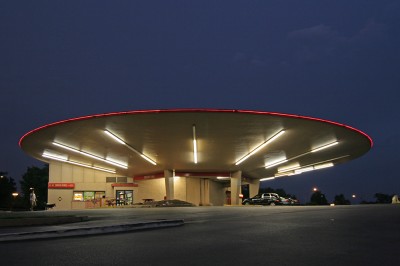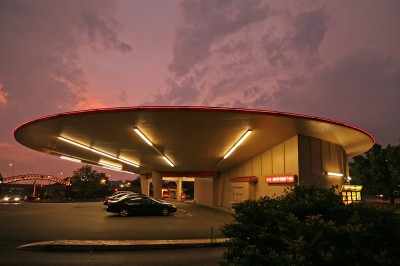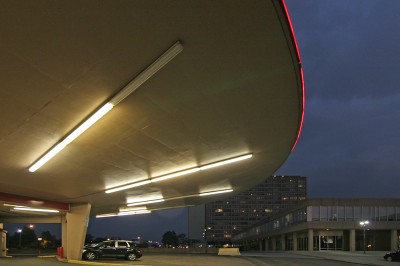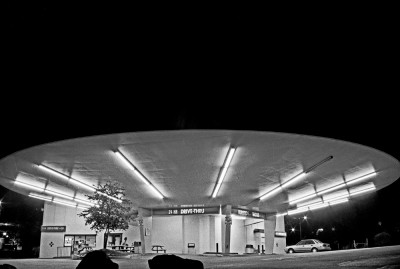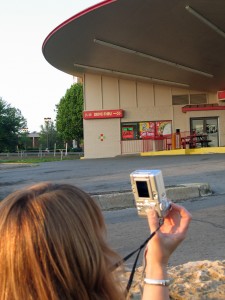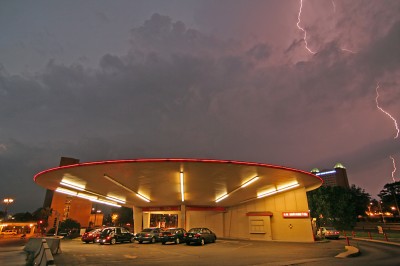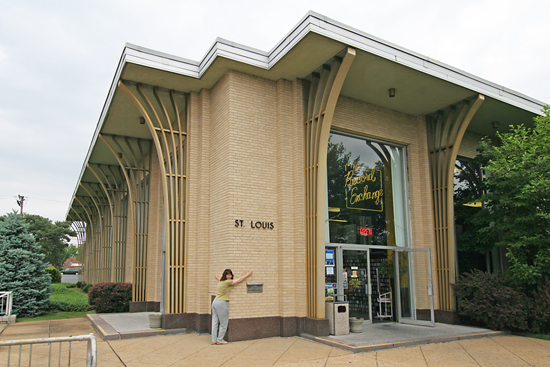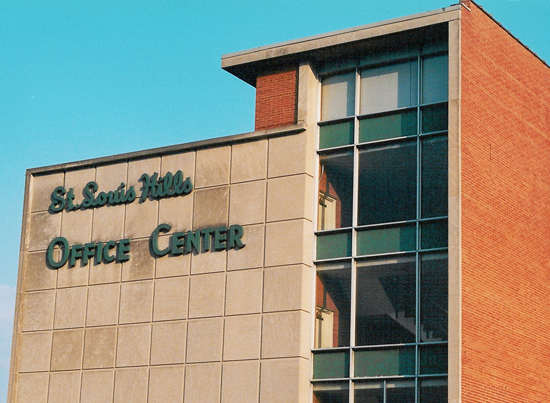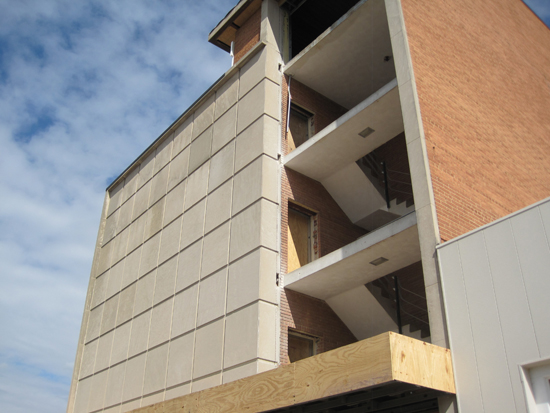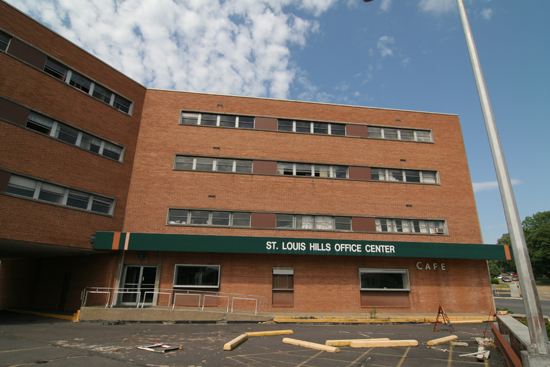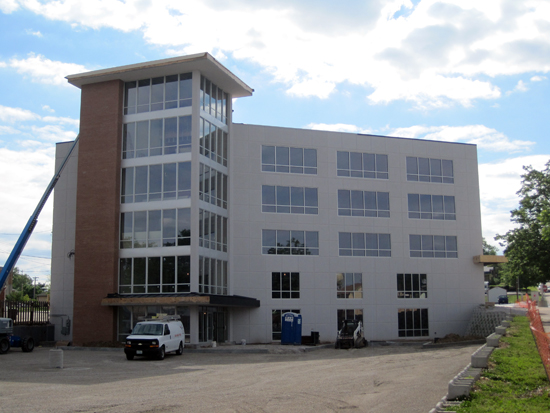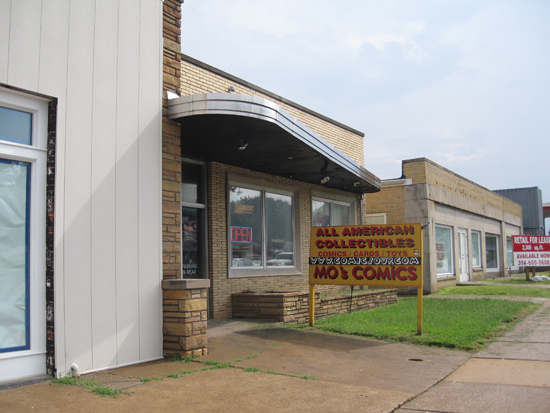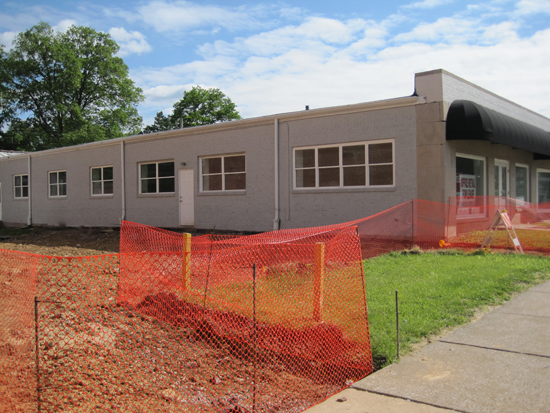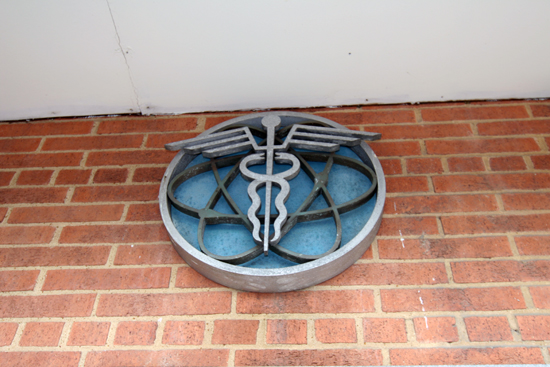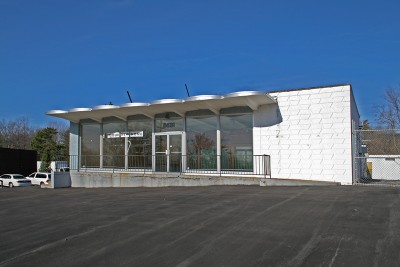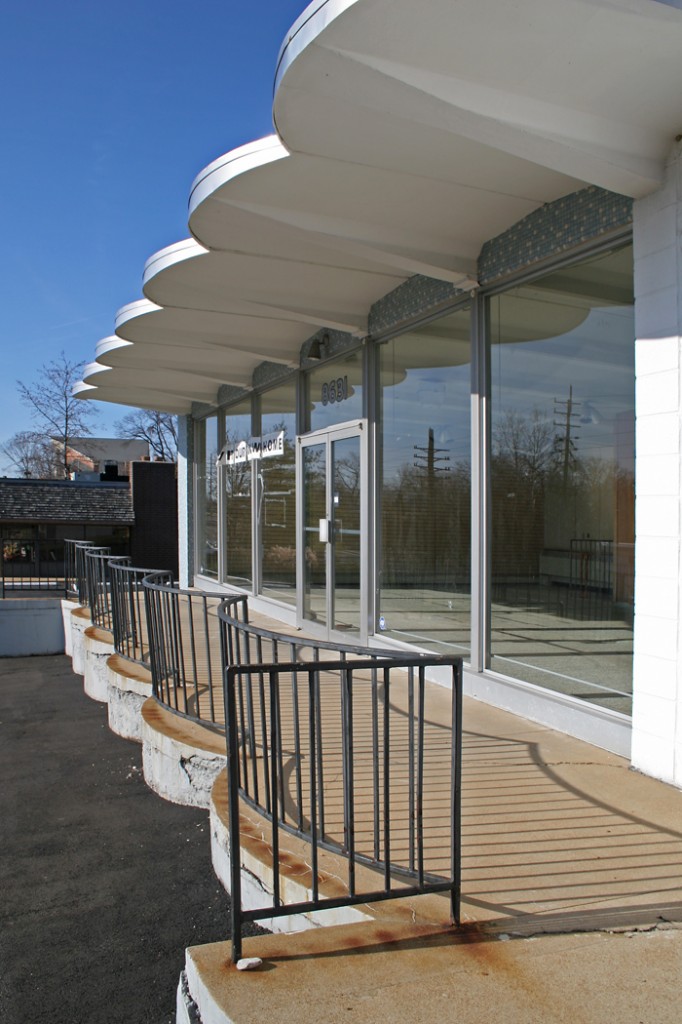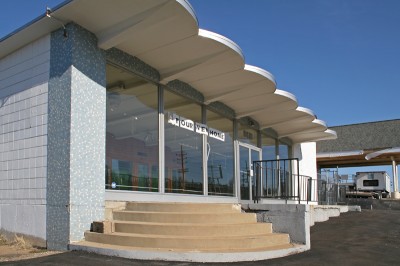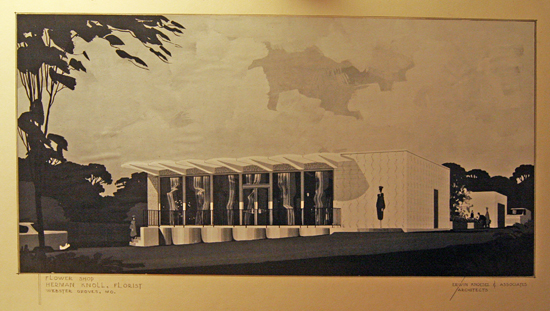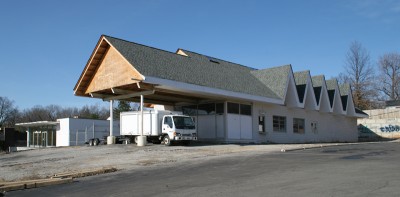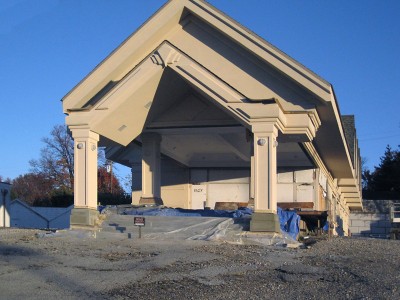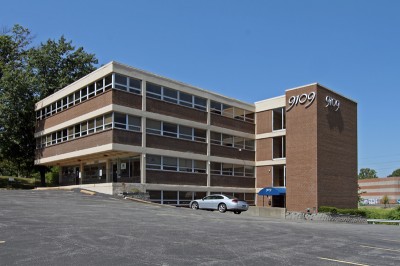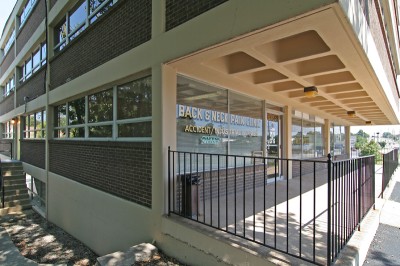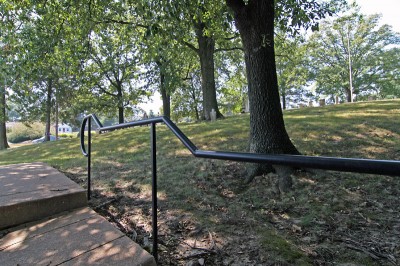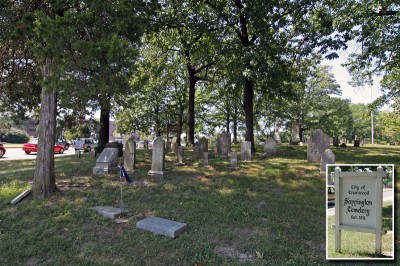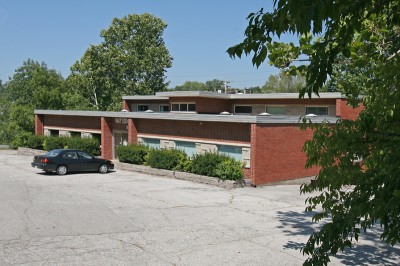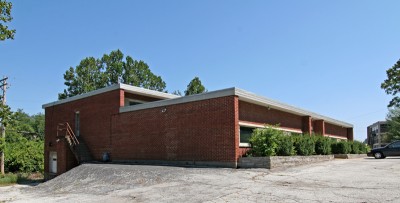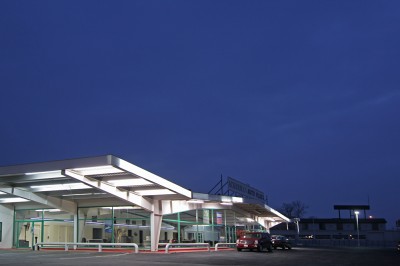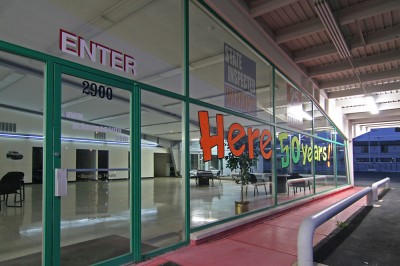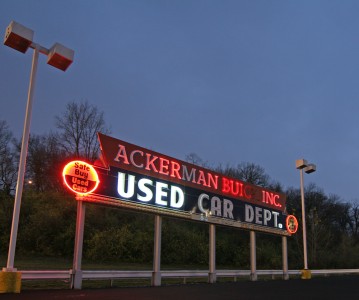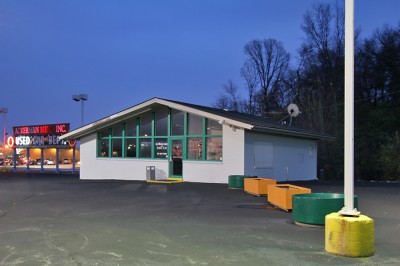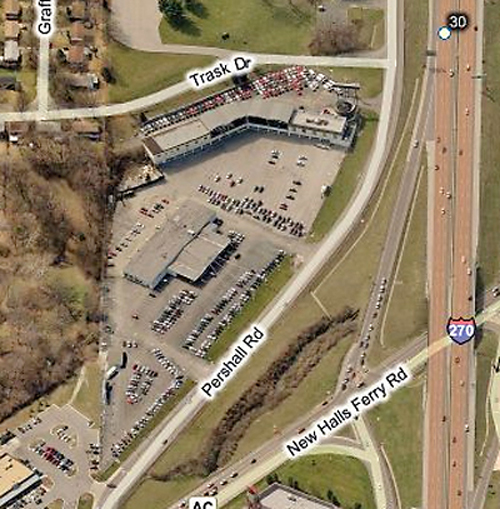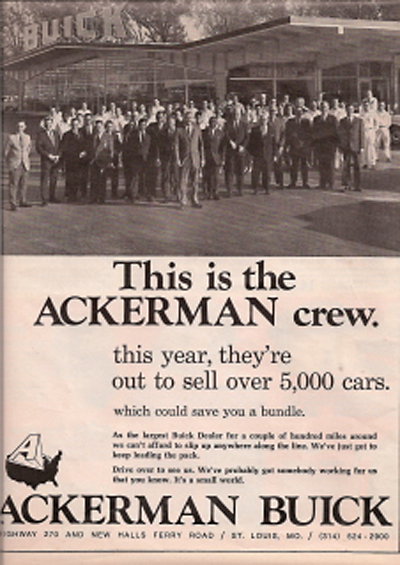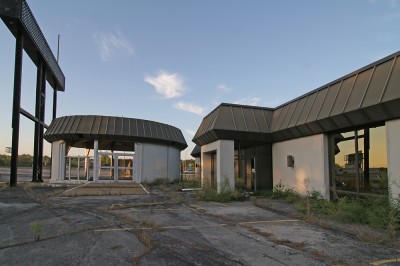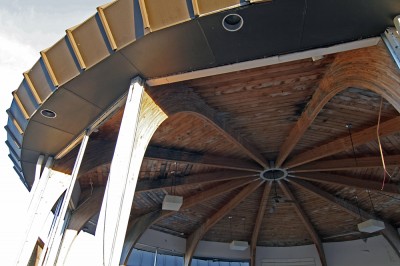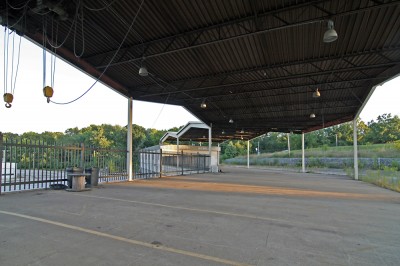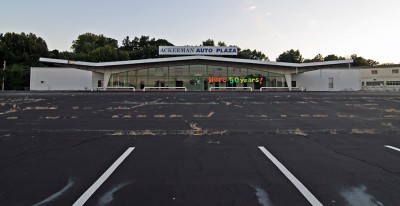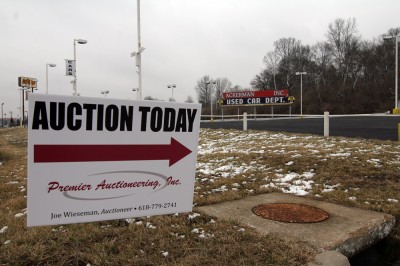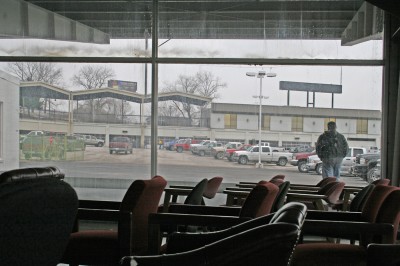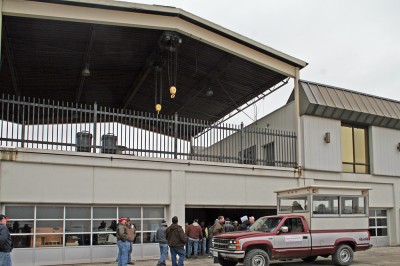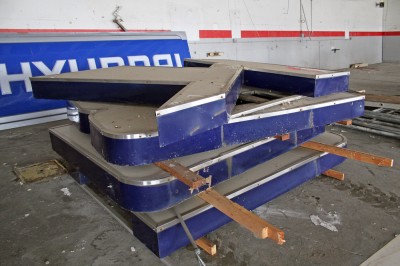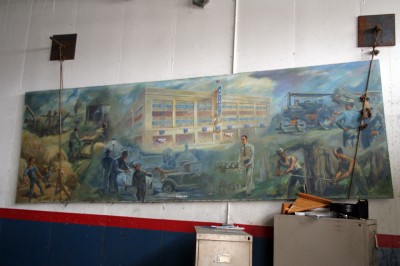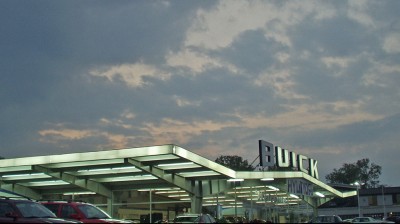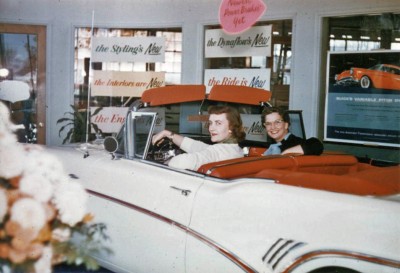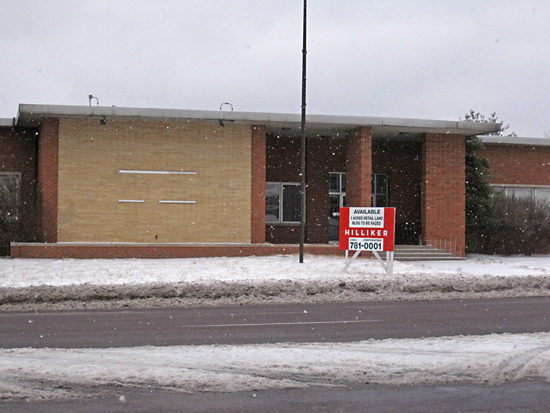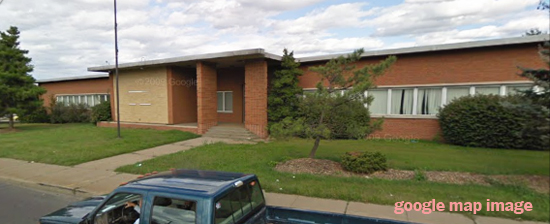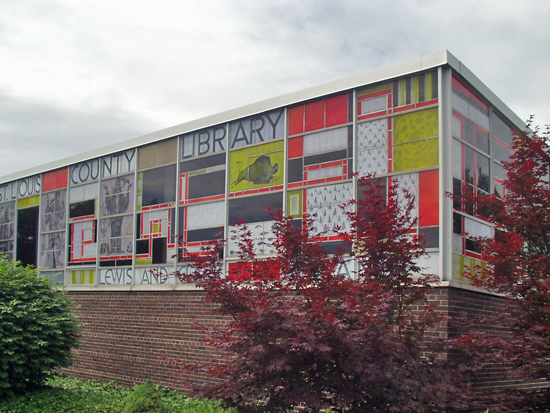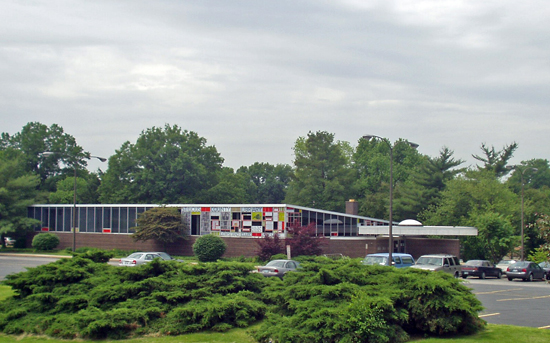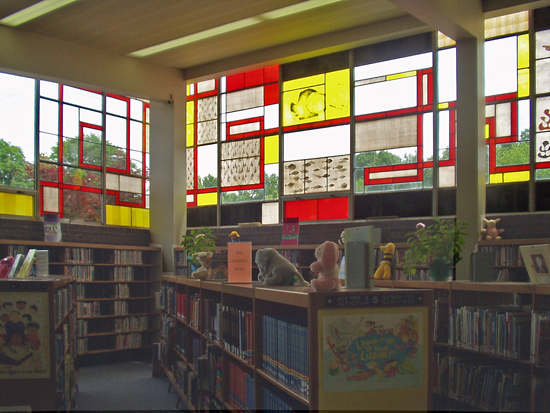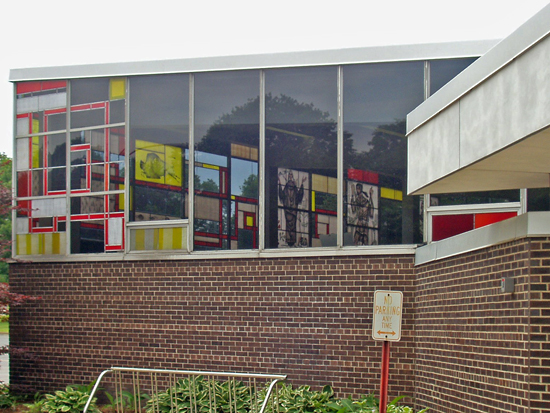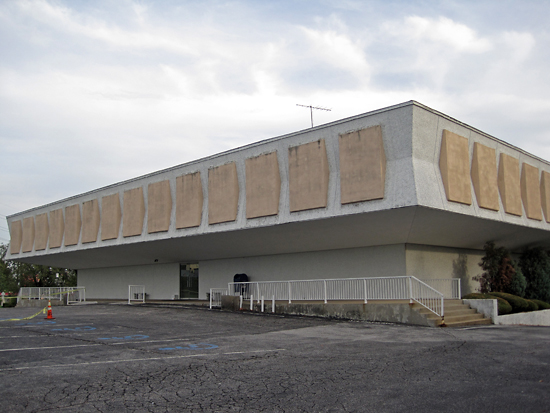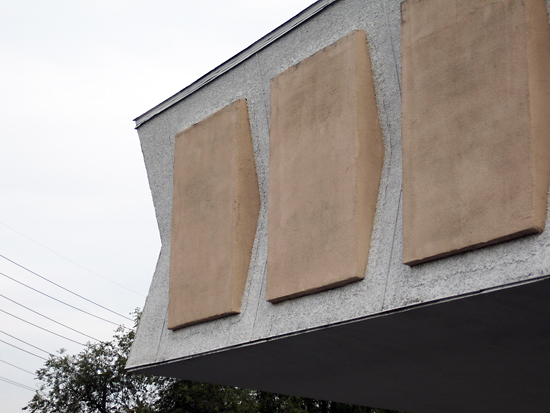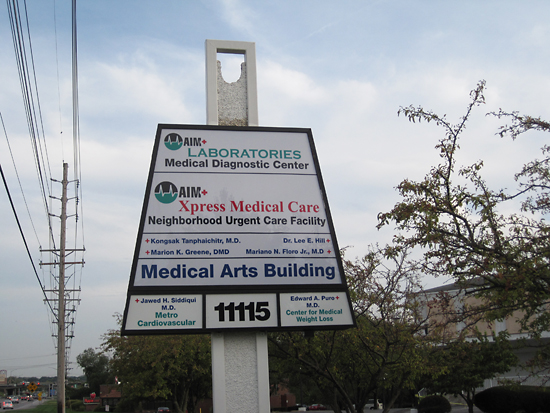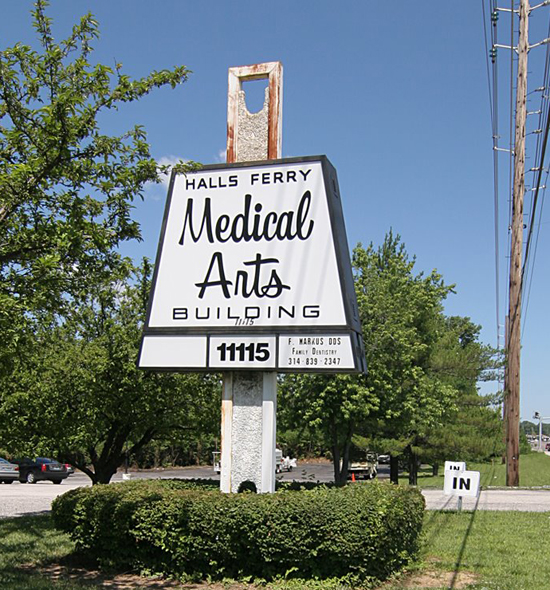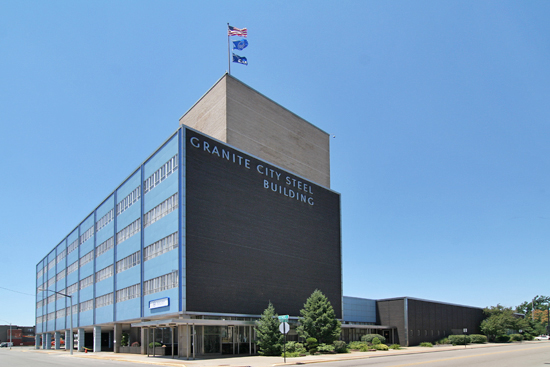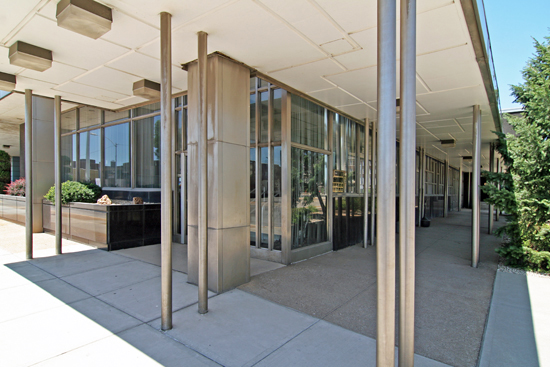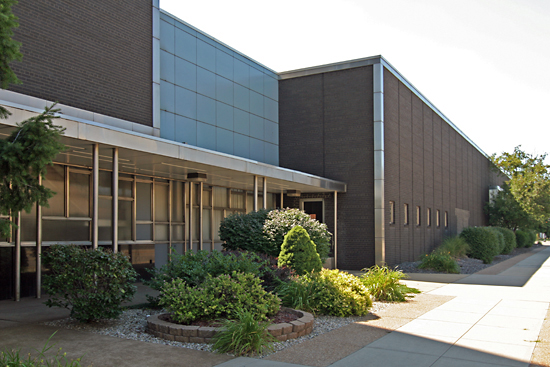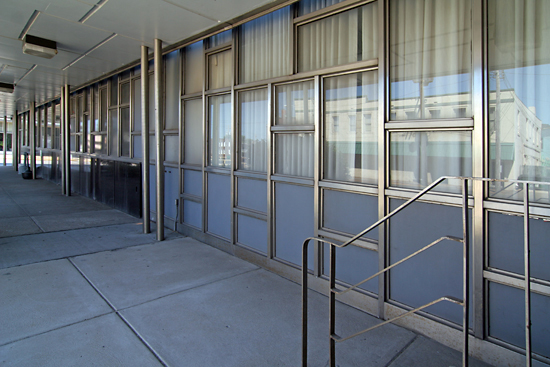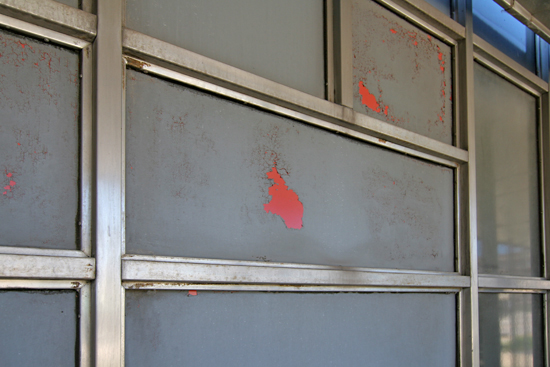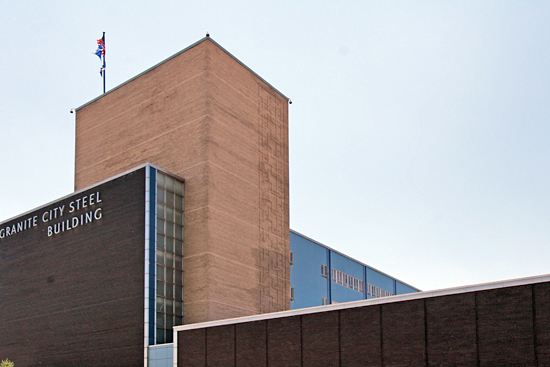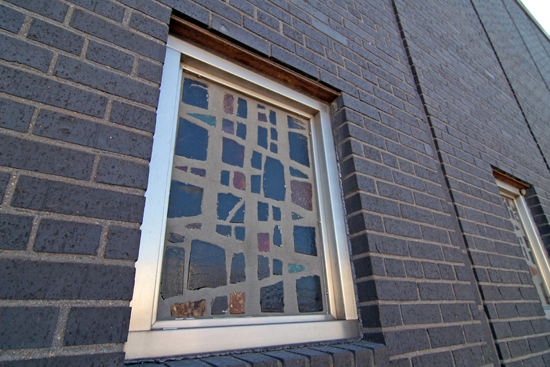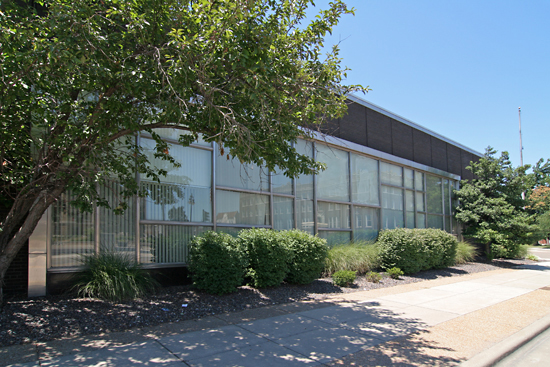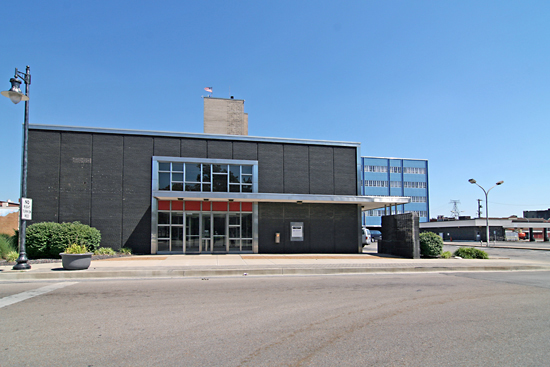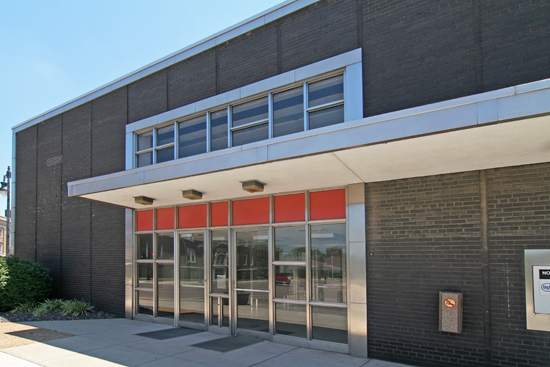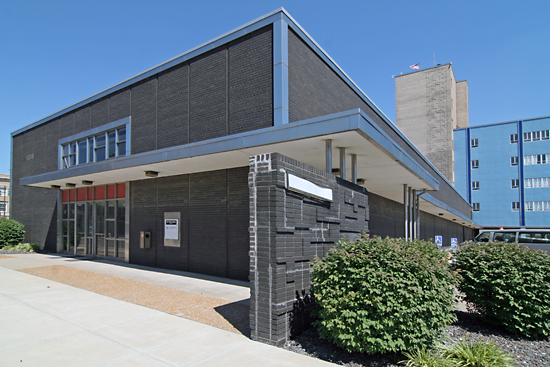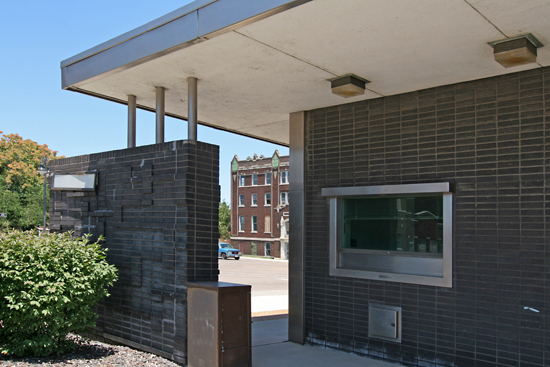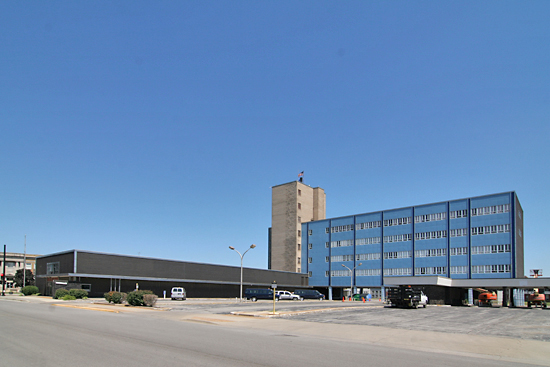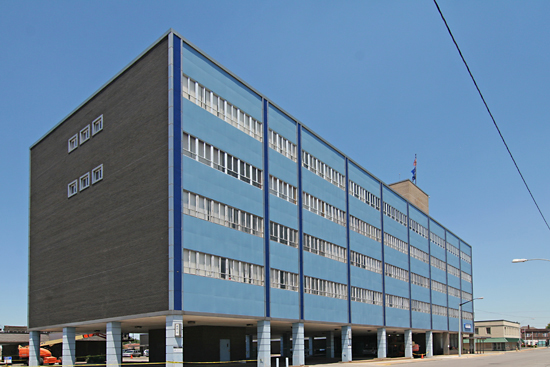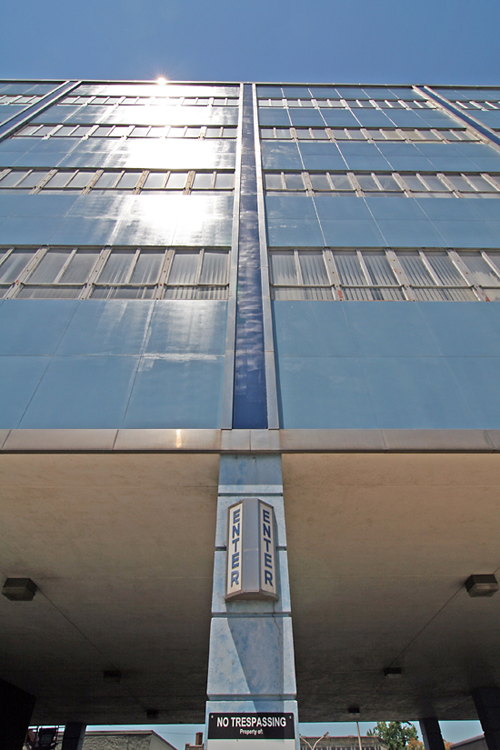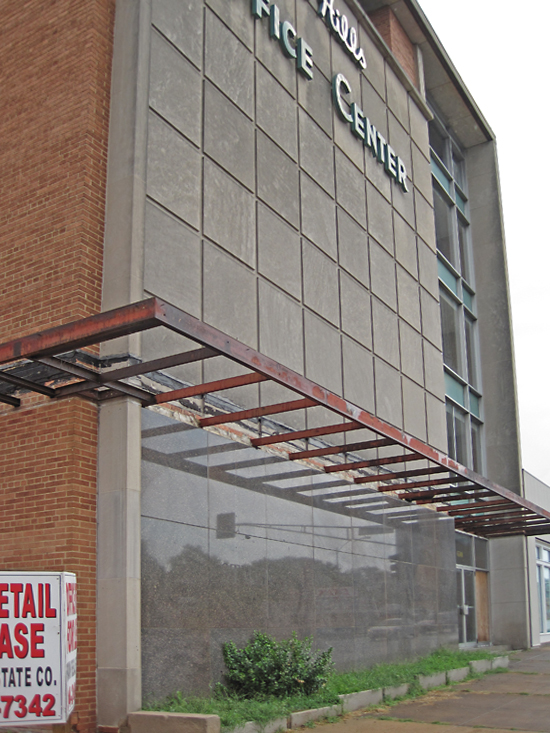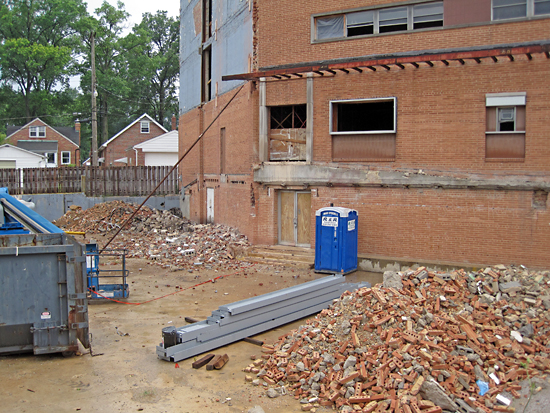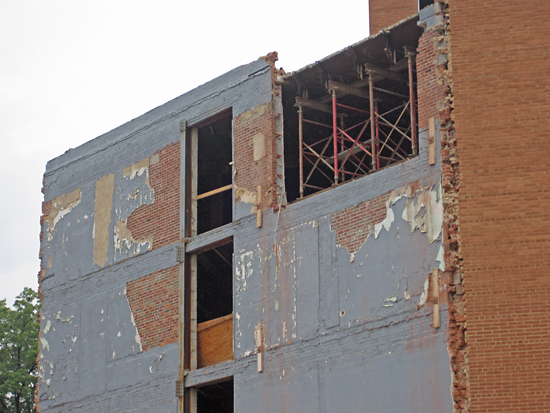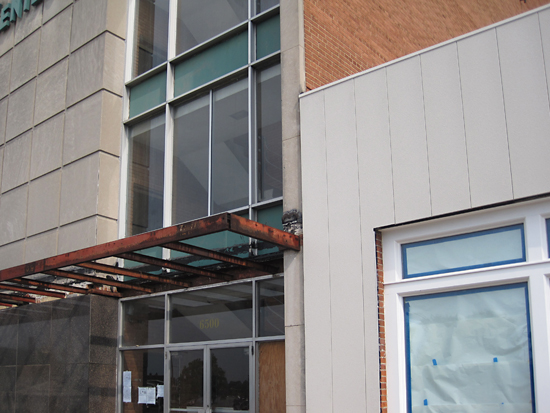St. Louis is energized over the intent to demolish the flying saucer-shaped Del Taco at South Grand and Forest Park Parkway. Those who love the iconic and unique googie-style building are coupled with those who love the fast food franchise in separate campaigns to save the building and its contents. Those in St. Louis City government who love the developer are fast-tracking a new bill that allows him to demolish a building he originally planned to keep standing, and let him do so without having to follow the usual legal process .
As a blogger concentrating on St. Louis mid-century modernism and an officer of the non-profit organization Modern STL, it’s obvious that I oppose the demolition of The Saucer. But for me, the real story is the troubling and flagrant display of personal politics overshadowing logical thought about the greater good and economic viability of Grand Center and MidTown (a.k.a. Politics As Usual in the City of St. Louis).
Here’s the bullet points of the story:
•In 2007, Developer Rick Yackey pays for a National Register application of all the buildings (including Del Taco) in the Council Plaza. Washington D.C. deems the entire Plaza historically significant and grants it a spot on the National Register of Historic Places. This National Register placement allows for the use of Historic Tax Credits to offset some Council Plaza redevelopment costs.
• In 2008, the developer is also granted a 10-year tax abatement by the City as part of the 374 South Grand TIF Redevelopment Plan, thus offsetting even more costs.
• In 2009, the corporation running Del Taco files for bankruptcy and allegedly stops paying rent to Council Plaza developers.
• In 2011, the developer wants paying tenants on that property, so revises the Council Plaza plans to demolish The Saucer for construction of a new building rather than find a new tenant for his existing Historic National Register building.
• On June 17, 2011, 19th Ward (where the Plaza resides) Alderwoman applies for an extension of the TIF set to expire at the end of 2011, with no mention of demolishing one of the contributing buildings.
• On June 25th, 2011, without supposedly reviewing details of his plans for the new building or its tenants, the alderwoman introduces a new bill that cancels previous demolition safeguards on the TIF site, and re-blights something that was no longer blighted because TIF monies had improved the site. This will allow the Developer to demolish The Saucer free of legal due-process previously put in place for just such an occurrence.
On the surface, this amounts to a major switcheroo, and begs the questions:
• Who knew what when and how long did they withhold this information?
• Is it OK for the City to condone a Developer playing all sides against each other to have their cake (i.e., historic tax credits and tax abatement) and eat it too?
• Since the City is investing our loss of tax dollars on this project, shouldn’t they diligently research exactly what the new plan is and if it will be economically sound?
The Developer Once Liked The Saucer
It is a common occurrence for development plans to change as a project moves along. At the time Rick Yackey and Bill Bruce bought the 9-acre Council Plaza site, Del Taco was basically the only regularly money-making building left on the site, as the office building and the 2 residential towers were nearly empty. With Del Taco filing bankruptcy in late 2009, it is presumed that they have had problems paying rent on a timely basis and – of this writing – employee rumor has it this particular franchise is now closed, or will be closing shortly.
So, the building that was essentially the only money-maker became a liability, and it’s logical that a development company paying for expensive construction would like some money coming in. As the landlords, they can now find new tenants. Since it’s a drive-thru, a Starbucks springs to mind as a good fit for the building and the area. Considering the building’s location and notoriety, finding a new tenant for one building may be easier than the expense of constructing a new building requiring multiple tenants.
The unique flying saucer building was originally built in 1967 as a Phillips 66 gas station. It had a unique pedigree, as well. At the time, Phillips 66 was known for its bat-wing model, a nation-wide design that came down from their corporate office. But in this rare case, the same architects that designed the rest of Council Plaza also designed this special edition of Phillips 66.
The Council Plaza architects were the firm of Schwartz & Van Hoeffen, who contributed many important buildings to the mid-century St. Louis landscape, including the Engineer’s Club (1959) and Optimists Club (1962) buildings on Lindell Boulevardin the Central West End, and the Mansion House Apartments (1967) in downtown St. Louis. Some of their buildings have already been demolished; these two men were part of the architectural team for the construction of the original Busch Stadium, and as principals in the firm Russell, Mullgardt, Schwartz & Van Hoeffen, they designed Northland Shopping Center, which opened in 1955 and was completely demolished by November 2005.
Aside from it being a fun building that’s captured the hearts of St. Louisans for so many decades, Michael Allen points out in this piece that “Its tapered round form anchors the corner of the complex and offers a memorable counterpoint to the rest of the complex.” But all of these factors weren’t even mentioned in the National Register Application (read it here); it was simply and logically included as one of the reasons “The Council Plaza fully retains its integrity of Design through the retention of its original form, plan, spaces, structure and style… integrity of Workmanship… fully retains integrity of Feeling… retains its integrity of Association and continues to function as it did when constructed.”
The Council Plaza Flats are now done, and there are some SLU students living there, but the retail aspect remains empty. Understandable, because these are tough economic times. If they are having a hard time finding paying tenants for the renovated building, what compels them to believe it will be viable to secure tenants for the proposed new-construction building? “Signed letters of intent from two national chain restaurants” is good, but check the definition of “intention” while looking at economic forecasts. By its nature, development is always a gamble, but this particular gamble feels foolish.
Talk of creating a more pedestrian-friendly building is laughable. All of Council Plaza was originally designed with cars in mind. And even though plenty of people do walk to Del Taco, until they take care of the dangerous intersections around it (and the new bill claims all streets and entrances will remain as is), there will never be anything remotely pedestrian-friendly about this site.
The Alderwoman Professes to Know Nothing
Council Plaza sits in the 19th Ward, which is governed by Ald. Marlene Davis. She smartly signed off on the original 2008 TIF plan, and when construction didn’t move along as quickly as planned (another common construction occurrence), she instituted a new plan on June 17th, 2011 that extends the TIF agreement that allows the developers until August 31, 2012 to finish the project.
But when it comes to this new change of plans, a June 23, 2011 St. Louis Post-Dispatch article about the proposed demolition reports this (bold face is mine):
Alderman Marlene Davis, whose ward includes the site, said she generally agreed with the plan, though she hadn’t been briefed on its specifics since a broader plan for neighboring Council Towers was approved in 2008. The area needs more shopping opportunities, she said, and, barring unusual circumstances, people have the right to tear down buildings that they own.
“I support the development plan that (Yackey) showed me, which includes new retail,” she said. “I’m not part of the decision-making process of what you may keep or change.”
If we take what she says at face value, it would mean that Ald. Davis has had no talks with the developers since 2008, until recently when she was given only the most minimal details about the proposed new building. But that was all she needed to hot-foot paperwork to introduce Board Bill 118, a proposed ordinance that includes a blight study of The Saucer (and – by association – claims that Council Plaza is still crime-ridden and unsafe; great way to attract tenants, yes?) and would abolish all the safeguards previously set in place to prevent easy demolition of any building in Council Plaza. In addition, the TIF would pay for the demolition. Read more about the bill and the blight study here.
Typically, a request for demolition in a historic district would need to go before the city’s Cultural Resources Office for debate. But in this case, in a matter of 3 working days from the TIF extension, someone took this blight request directly to the St. Louis Redevelopment Corporation for quick approval and created Bill 118 that takes the matter directly to the Board of Alderman (BOA), thus bypassing any prolonged demolition applications and potentially messy debates about the building’s merit.
Exactly who worked so quickly and diligently to pass through this change of plans? I wonder, because Davis implies she doesn’t really know any specifics about the new plans. So what would compel her to work so quickly for an undefined plan? Of course she supports changes that improve economic development in her ward, but in this case, what are these changes, exactly? If you’re going to bat for something, wouldn’t you want details? You surely wouldn’t go to all this effort merely on the word of a developer, would you?
The other troubling aspect of her public statement to the newspaper is: “I’m not part of the decision-making process of what you may keep or change.”
Any business looking to renovate a building – with or without historic tax credits – in the City of St. Louis has to work with their ward’s alderman to assure an achievable goal. Seeking their assistance is a normal part of the process. And monitoring the condition and viability of any income- or tax-producing building in their ward is most definitely part of their regular duties. It is safe to say that the majority of the successfully re-emerging business and residential districts in the City of St. Louis were made possible because of the decisions of an alderperson. Just as it is safe to say that most buildings that come down in St. Louis did so only after its alderperson weighed in on the matter.
In the case of this change of plans at Council Plaza, it is artless and graceless for Ald. Davis to claim in the press that she has no part in the decision-making process. And it’s curious to assume that her peers on the BOA should automatically approve plans she claims to lack details on. Either she knows full well all the details (and since she’s endorsing it, should be proud of it), or she truly doesn’t know details and is simply counting on the “business as usual” tradition of Aldermanic Courtesy to take care of developers the City already holds in favor.
Either way, it’s another discouraging example of why St. Louis continues to lack self-esteem in the realm of commandeering this City toward a strong economic viability that also bolsters civic pride (and undoubtedly, pride bolsters a city’s economy). What is the point of all the paperwork and expense of Historic Designations, TIF ordinances and due process if it will all be shunted aside by aldermanic loopholes – both legal and courteous?
Also discouraging is the lack of Big Picture Thinking on the matter of The Saucer. Grand Center just launched their initiative to build a better “sense of community” with a “serious planning effort” for a common vision for the area. Anyone who’s ever come to Grand Center from Highway 40 knows they’ve arrived when they see The Saucer – it’s like the entry gate to our cultural district. If City Hall needs proof that this building matters to us, take a look at the numbers and the comments on the Facebook page that immediately sprung up to oppose its demolition.
All this media attention would sure make it easier to find a new, paying tenant for the Spaceship historical landmark. And if the BOA were to take a break from Aldermanic Courtesy and deny demolition, all that joy and civic pride would come in handy during the next (odd-numbered ward) aldermanic elections.
What You Can Do
• This Wednesday, June 29, 2011 at 10a.m. in room 208 of City Hall is when the Housing, Urban Development and Zoning Committee (HUDZ) invites the public to weigh in on this bill to allow for the demolition of The Saucer for a new building we yet know nothing about. Show up and share your thoughts.
• You can also sign this petition, which is a joint effort by nextSTL and ModernSTL, and will presented to the BOA before a final vote is made on Bill 118.
• You can contact Ald. Davis with your views. You can also contact any of the members of the HUDZ committee (find their contact info here), who are:
Fred Wessels, Chair – 13th Ward
Jennifer Florida – 15th Ward
Terry Kennedy – 18th Ward
Charles Troupe – 1st Ward
April Ford-Griffin – 5th Ward
Phyllis Young – 7th Ward
Stephen Conway – 8th Ward
Kenneth Ortmann – 9th Ward
Gregory Carter – 27th Ward
Lyda Krewson – 28th Ward
Marlene E Davis – bill sponsor
Jeffrey L Boyd – 22nd Ward
If you love the building, speak up. If you could care less about the building but dislike this type of St. Louis City politics, speak up. Suggesting solutions is always better than mere griping.

